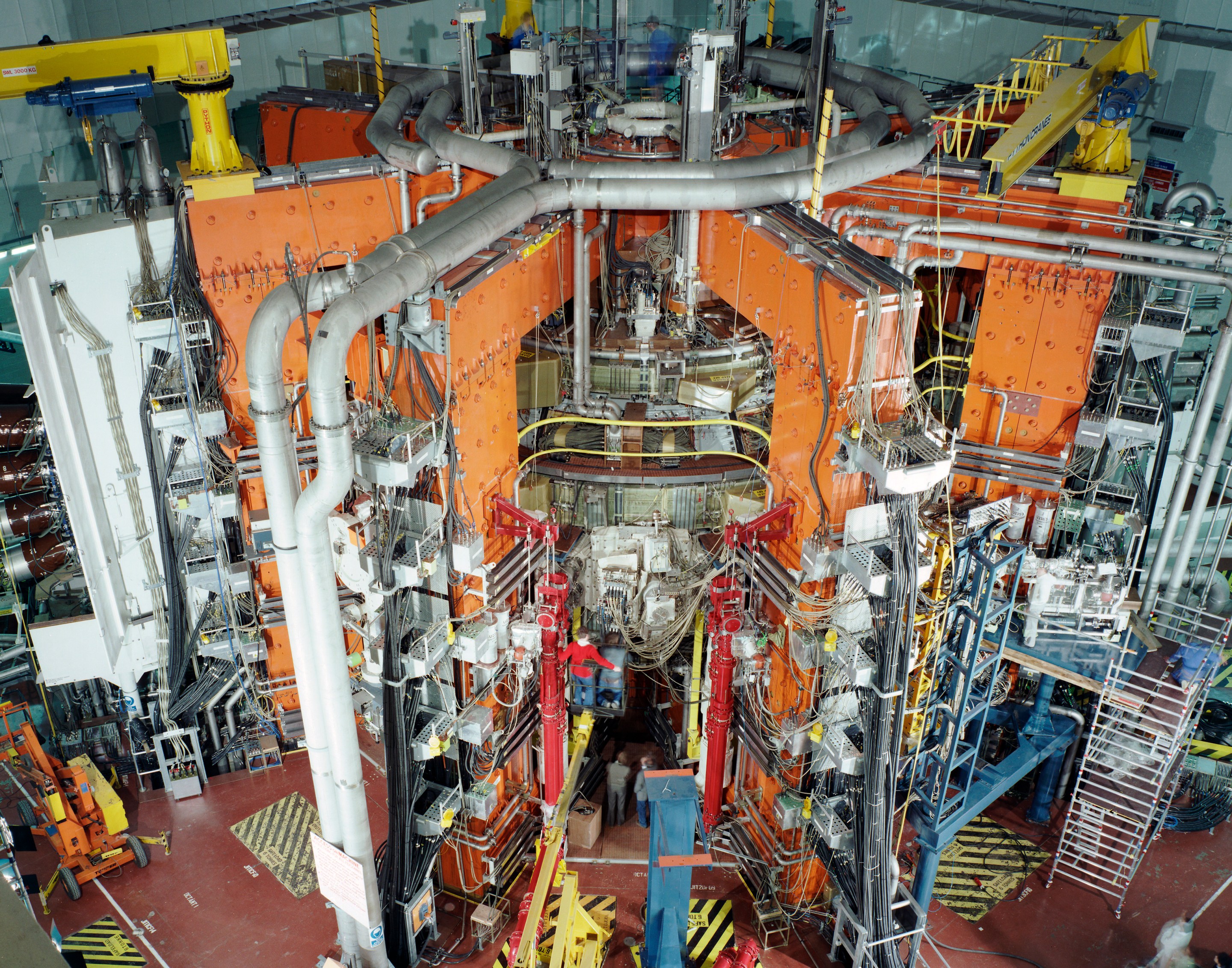Scientists Move Another Step Closer To Harnessing The Unfathomable Power Of A Star
2:28 PM EST on February 9, 2022

The Joint European Torus, a big honkin' experimental tokamak located in Oxfordshire, England, recently completed a years-long upgrade that would allow it to once again use the deuterium-tritium cocktail of hydrogen isotopes—the same deuterium-tritium cocktail that researchers believe will soon allow a magnetic confinement reactor to produce an energy-positive plasma fusion reaction—in its latest rounds of fusion experiments. Big whoop, you are saying.
My home reactor uses deuterium-tritium for all its plasma fusion experiments, you go on to say, gesturing at your countertop coffee-maker, and I haven't upgraded it in more than a decade. All of that is just absolute gibberish, man. Do we have to go over this again?
The Joint European Torus (JET) is a tokamak, a huge hollow metal donut inside of which scientists play with glowing blobs of magnetically confined plasma, in order to study nuclear fusion. Nuclear fusion—atomic nuclei smashing together and forming different nuclei and subatomic particles, and releasing lots of sweet, sweet energy—only happens under the most extreme conditions, like those found in the core of the Sun. Unable to produce a star's unfathomable gravitational forces within a laboratory, fusion researchers instead use supercooled magnets to suspend and animate clouds of carefully mixed hydrogen isotopes inside a donut-shaped torus, and carefully input doses of thermal energy to act as the ignition. The incredible heat produced by the reaction—150 million kelvin, or 10 times hotter than the hottest part of the Sun—triggers nuclear fusion, the energy output of which triggers more fusion and becomes self-sustaining. A reaction that produces more energy in this way than it consumes in thermal input will have reached the elusive point of "breakeven" and become energy-positive. This is the practical goal of modern fusion research: To develop a clean source of limitless energy, and overhaul humankind's warping and consuming energy dependence, at least until the billionaires buy up the technology and life resumes sucking shit in all the familiar ways.
So retrofitting JET so that it can once again burn the key fuel for eventual commercial energy applications is no small deal. Nevertheless I must admit that I share your overall spirit of derision, if not your deeply weird insistence that various kitchen appliances are capable of self-sustaining plasma fusion reactions. The JET reactor first burned deuterium-tritium all the way back in 1991! Do not wake me from a peaceful night's sleep with news that a particular fusion reactor is now able to use a type of fuel that it successfully burned in experiments more than 30 years ago. I simply will not rise from bed for anything less than record-shattering energy outputs! Give me big impressive statistics or give me an uninterrupted night of rest!
But this is where the magnetic confinement fusion community is serving up news worthy of genuine excitement: In its first round of deuterium-tritium experiments in 25 years, run at the end of 2021, JET fired up a plasma cloud generating 59 megajoules of energy over a span of five seconds. While this is not a huge amount of energy, it's approximately 45 times as much as the record yield for inertial confinement fusion, set in August 2021. And these results represent a significant leap forward from the 1997 experiment, when JET produced a then-record 22 megajoules of energy. As JET is the only tokamak currently using deuterium-tritium in its plasma experiments, every time it produces more energy, it is also setting a new world record. More importantly, as experiments shift from maximizing yield to stabilizing the reaction for longer periods and achieving self-sustenance, lengthening the period of peak output from 0.15 seconds in 1997 to five seconds in December 2021 is a big deal: JET researchers more than doubled the total energy output, and extended the reaction's duration exponentially. Now that's a damn breakthrough!
But don't take my word for it! Ian Chapman, chief executive of the United Kingdom Atomic Energy Authority, told Physics World that the latest experiments "have taken us a huge step closer to conquering one of the biggest scientific and engineering challenges of them all." Bernard Bigot, the director of the enormous International Thermonuclear Experimental Reactor, currently being built in the south of France and expected to produce energy-positive 500-watt thermal outputs in shots lasting up to 10 minutes at a time, says JET's results provide "a resounding confirmation to all of those involved in the global fusion quest." As a layperson who at the mention of 500 watts pictures the large extended family of a Cardinals defensive lineman, I am happy and even thrilled to take encouragement from the words of these professional science knowers. Anything that moves mankind meaningfully closer to dominion over star juice is excellent news, in my book.
Experimental tokamaks all over the world are advancing fusion science in leaps and bounds. In June 2021, China's tokamak, nicknamed EAST, set a new duration record for plasma temperatures in excess of 100 million degrees centigrade. The time is fast approaching when fusion science moves from experimental to commercial, with the all-important "breakeven" serving as the tipping point. These UK types are planning a prototype commercial fusion reactor, the Spherical Tokamak for Energy Production (STEP), for 2040, based on the science they've learned at JET over the last 38 years. Meanwhile, researchers at MIT and with Commonwealth Fusion Systems are already manufacturing and testing component parts of the SPARC reactor, a commercial prototype tokamak using Big Magnets and burning deuterium-tritium, and scheduled to go online and achieve energy positivity in 2025. 2025! It is already 2022! If the science works, we could soon have tokamak reactors all over, in our own communities, burning clean fuel, juicing up our appliances, holding little glowing balls of The Breath of God. Imagine the possibilities!
If you liked this blog, please share it! Your referrals help Defector reach new readers, and those new readers always get a few free blogs before encountering our paywall.
Staff Writer
Read More:
Stay in touch
Sign up for our free newsletter
More from Defector
How Do You Get Americans To Care About A War?
Ethiopia's not hard to get to. It's very hard to sell as a story.




